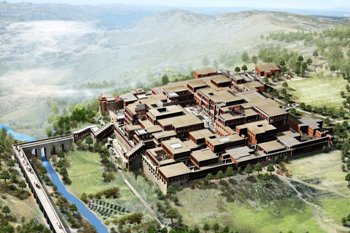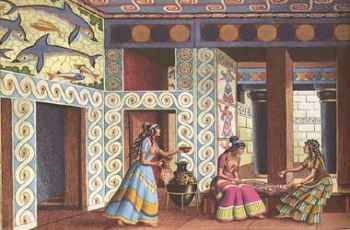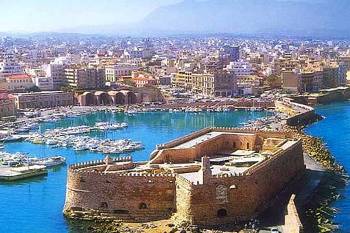History at a glance
6.000 - 2.000 BC - Neolithic Period
The very few remains reveal that Neolithic man in Crete had permanent housing, he lived off farming and stockbreeding and he used tools made of stone and utensils of clay
2.600 - 1.100 BC - Minoan Period
Around 1900 BC the first Minoan palaces were established at Knossos, Phaestos, Malia and Archanes. The navy and commerce were flourishing, settlements were found on other islands like Milos, Kythera and Santorini and commercial trade with Cyprus, Egypt and Syria was very important for the Minoans. Around 1700 BC an earthquake hit the island and brought disaster. But the Minoans recovered and the cities were rebuilt greater in size and splendour.
During this period the Minoan civilization is at its peak. The prosperity is appearing in every form of art. In pottery, sculpture, vase making, fresco painting, decoration on weapons and tools, jewellery.


However, around 1450, the eruption of the volcano of Santorini occurred and yet again great destruction was brought to the island.
The invasion of the Acheans who occupied Knossos followed and their rule was established.
1.100 - 650 BC - Geometric Period
Around 1100 the Dorians from mainland Greece, armed with iron weapons invaded the island and forced the descendants of the Minoans, to withdraw to the mountains, where they preserved their customs for a number of centuries, but were unable to communicate with the outside world.
650 - 500 BC - Archaic Period
City-States began to be formed, the population of the island increases, the Dorian Crete excels culturally and flourishes. But not for long. A series of invasions bring Crete to its dark age.
500 - 67 BC - Classical and Hellenistic Period
During this period while Greece develops, Crete fell into obscurity. Civil conflicts kept Crete away from the Persian or Peloponnesian war. Pirates used the island's shores as a base for their operations. Thus the Romans found an excuse to undertake their occupation. It's the beginning of the Roman period for Crete.
67 - 330 AC - The Roman Period
The roman governor settled in Gortyna which was appointed as the Roman capital. The Romans had an influence but did not affect the Greek character of the island. Latin is the official language, but Greek was preserved and even the Roman settlers will succumb to the Greek lifestyle. Crete will be one of the first regions of the western world to receive the Christian religion, spread by Apostle Paul's pupil, Titos.

330 - 1669 Byzantine - Arabs - Venetians
Crete will be part of the Greek Byzantine Empire and Christian religion will prevail on the island.
In 824 Crete was captured by Arab raiders, who organized it into an independent Arab state with Handaka (today Heraklion) as the capital. The Greek population suffered into the darkness of slavery while Heraklion became known for its slave markets.
Finally in 960 AD a Byzantine emperor liberated Crete from the Arabs.The Greek element was strengthened with Christian settlers from other Byzantine provinces and once more there was cultural prosperity, peace and stability on the island. With the capture of the fourth crusade, the Byzantine Empire was divided. Crete was given to Boneface of Montferrat who sold it to the Venetians at a cheap price.
In the years that followed, Venetian presence on the island lead to an impressive social and cultural rebirth of Crete. Because of the Turkish threat and their attacks, Venetians and Cretans managed to co-exist.

1669 - 1898 - The Turkish occupation
After a 21-year long siege, Candia (the Venetian name for Heraklion) was forced to surrender into a dark, violent period that will terminate any process of development for at least 200 years. Many of the churches were demolished or turned into mosques. Brutal slaughters took place against the Christians. Two main revolts helped Crete to its autonomy. The first one in 1866, was a bloody conflict which lasted 3 years and led to a mass suicide of Cretans who blew up the monastery of Arkadi to avoid capture. The second one took place in 1895 with extended slaughters that lasted 2 years and convinced the Europeans that the Sultan can't control Crete any more. This led to partial autonomy and later unification of Crete with Greece was accomplished in 1913.
1898 - today
From this point the island followed the fate of Greece. After the agreement regarding the
interchange of populations, the Muslims of Crete were exchanged with Greek refugees from Asia Minor. In 1941 the Germans, after occupying mainland Greece, combined air force and Navy in order to occupy the island. The well-known "Battle of Crete" lasted 10 days, with Greek, British, Australian and New Zealander soldiers fighting side by side with the Cretan folk.
German occupation in Crete lasted for 4 years. After the end of the war, the island was left with a destroyed infrastructure but a period of reconstruction and progress began, which turned Crete into one of the most prosperous areas of Greece.


